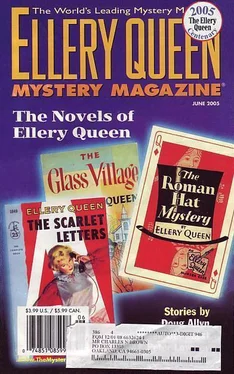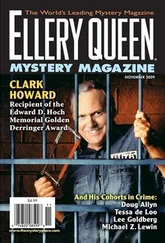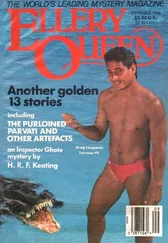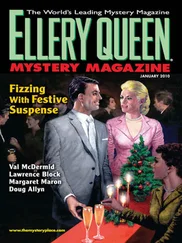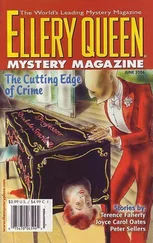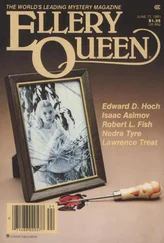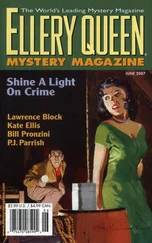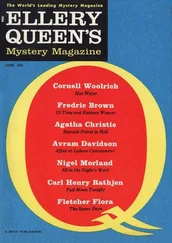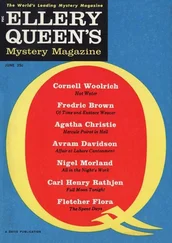Doug Allyn - Ellery Queen’s Mystery Magazine. Vol. 125, No. 6. Whole No. 766, June 2005
Здесь есть возможность читать онлайн «Doug Allyn - Ellery Queen’s Mystery Magazine. Vol. 125, No. 6. Whole No. 766, June 2005» весь текст электронной книги совершенно бесплатно (целиком полную версию без сокращений). В некоторых случаях можно слушать аудио, скачать через торрент в формате fb2 и присутствует краткое содержание. Город: New York, Год выпуска: 2005, ISBN: 2005, Издательство: Dell Magazines, Жанр: Детектив, на английском языке. Описание произведения, (предисловие) а так же отзывы посетителей доступны на портале библиотеки ЛибКат.
- Название:Ellery Queen’s Mystery Magazine. Vol. 125, No. 6. Whole No. 766, June 2005
- Автор:
- Издательство:Dell Magazines
- Жанр:
- Год:2005
- Город:New York
- ISBN:ISSN 1054-8122
- Рейтинг книги:3 / 5. Голосов: 1
-
Избранное:Добавить в избранное
- Отзывы:
-
Ваша оценка:
- 60
- 1
- 2
- 3
- 4
- 5
Ellery Queen’s Mystery Magazine. Vol. 125, No. 6. Whole No. 766, June 2005: краткое содержание, описание и аннотация
Предлагаем к чтению аннотацию, описание, краткое содержание или предисловие (зависит от того, что написал сам автор книги «Ellery Queen’s Mystery Magazine. Vol. 125, No. 6. Whole No. 766, June 2005»). Если вы не нашли необходимую информацию о книге — напишите в комментариях, мы постараемся отыскать её.
Ellery Queen’s Mystery Magazine. Vol. 125, No. 6. Whole No. 766, June 2005 — читать онлайн бесплатно полную книгу (весь текст) целиком
Ниже представлен текст книги, разбитый по страницам. Система сохранения места последней прочитанной страницы, позволяет с удобством читать онлайн бесплатно книгу «Ellery Queen’s Mystery Magazine. Vol. 125, No. 6. Whole No. 766, June 2005», без необходимости каждый раз заново искать на чём Вы остановились. Поставьте закладку, и сможете в любой момент перейти на страницу, на которой закончили чтение.
Интервал:
Закладка:
Ellery Queen’s Mystery Magazine. Vol. 125, No. 6. Whole No. 766, June 2005
The Novels of Ellery Queen
by Edward D. Hoch
Anthony Boucher once wrote, “Ellery Queen is the American detective story,” and certainly no other American writer was so active, for such a long period, in so many different aspects of mystery writing. From 1929 to 1982 the name was in the forefront of mystery writing, editing, and scholarship. Queen not only produced some of the best detective novels of the so-called “Golden Age” (roughly 1920 to 1940) but also continued to publish important — and sometimes classic — novels during the decades that followed.
Frederic Dannay and Manfred B. Lee’s first joint effort under the Ellery Queen name was The Roman Hat Mystery, published on August 15, 1929. It was an immediate success, transporting readers to the glamorous Broadway theater world where a clever blackmailer named Monte Field is poisoned while seated in the last row of the orchestra at the Roman Theatre. Inspector Richard Queen is in charge of the case, and his son Ellery joins him at the scene of the crime. Virtually the first words out of Ellery’s mouth are, “You just lured me away from a perfect book-lover’s paradise,” thereby establishing his character as surely as Rex Stout established Nero Wolfe’s character five years later with his first words in print: “Where’s the beer?”
The investigation moves from the Roman Theatre to Monte Field’s bedroom, where late in the book a secret compartment full of top hats is discovered. Some seventy-five pages before the finish, Queen stopped the action with the first of his famous challenges to the reader. All the clues have been given and Ellery knows the identity of the killer. Does the reader? The action resumes and moves on to a capture just as the killer is about to strike again. The final chapter, a letter from his father to Ellery, outlines the clues that helped them arrive at the surprising solution.
Though few critics today would list The Roman Hat Mystery among the ten best Queen novels, that is only because it has been eclipsed by far better adventures in the decades that followed. It remains an amazing achievement for a first novel, and was to set the pattern for the first nine Queen novels. All would have similar titles using a nationality, a common noun, and the word “Mystery.” Most would feature a Challenge to the Reader, and most would have lengthy, complex solutions revealing the killer to be the least suspected person.
Queen’s second novel, The French Powder Mystery, was published just a year after the first. It contained many of the same elements — an unfamiliar setting (this time a department store), a large cast of characters, some complex but logical deductions, and the usual Challenge to the Reader. But this time the authors added something more. The solution is so cleverly constructed that the killer’s name is withheld until the final two words of the book. It was a feat that could be topped only by Queen himself in a later book (which shall be nameless here), in which the killer’s name appears only as the first words of the novel and its last words — but is found nowhere else in the book!
The Dutch Shoe Mystery, about murder in the Dutch Memorial Hospital, was published in 1931. Its plot, involving a killer disguised as a doctor who strangles a patient awaiting emergency surgery, is almost as good as the first two Queens — but the best was yet to come. In 1932 they published four of their best early novels in a single year.
For the first of these they decided to adopt a second pseudonym and acquire another publisher. They became “Barnaby Ross,” chronicling the cases solved by Drury Lane, a retired Shakespearean actor forced to give up his career because of deafness. The first Lane novel, The Tragedy of X, was Dannay and Lee’s best book to date — a baffling mystery that cleverly uses varying modes of transportation for its settings. Thus the first murder, by nicotine poisoning, occurs on a crowded Manhattan streetcar. It is followed by murder on the Weehawken ferry to New Jersey, with the murderer finally unmasked aboard a train in New Jersey. The Tragedy of X has been called by Francis M. Nevins, Jr. (Royal Bloodline) a book of staggering complexity, stunning ingenuity, and dazzling fairness to the reader. As such, it was the first truly classic mystery to come from the pens of Dannay and Lee.
It was followed within three months by an equally complex and rewarding novel under the Queen name, The Greek Coffin Mystery. The longest and best of the early novels about Ellery, it involves the death of a wealthy old man, and the strangled body of a second man found in the coffin with him. The complicated plot features some dazzling detective work involving a typewriter, and a least-suspected person that should surprise even the most astute Queen reader. The book marks Queen’s first use of multiple solutions. In fact, four solutions are given during the course of the novel, with the true one the most astounding and satisfying of all.
Their third book in 1932 was another Drury Lane adventure under the “Barnaby Ross” name. The Tragedy of Y is a favorite Queen novel among Japanese readers, and American critics differ only on whether it or X is the best of Lane’s cases. Its portrait of the doomed Hatter family is superb, and the solution once again breaks totally new ground. Its least-suspected person has been used since then by other writers, but this was its first use in a detective novel.
The year ended with the publication of The Egyptian Cross Mystery, Ellery’s fifth case and yet another dazzling performance. The crucifixion of decapitated bodies made for some bloody murder scenes, but there was method in the killer’s seeming madness and one could forgive the gore in the face of some fine detective work and another surprising solution.
In 1933 the third of Drury Lane’s adventures was published. If The Tragedy of Z marked a falling-off from the classic stature of the first two books, it was still a very good mystery. Patience Thumm, a police inspector’s daughter, narrates the story and though parts of the narration are awkward, one still wishes she could have developed into a series character on her own. The murders here take place near a state prison in upstate New York, and the book features two memorable scenes in the prison’s execution chamber. Drury Lane arrives at the killer’s surprising identity by establishing four traits or qualifications which he must have, based upon the clues, and then ruling out all but one of the possible suspects. It was a clever technique that Queen would use again. Another plot element, mysterious packages delivered to the victims before their murders, hinting at vengeance from the past, would reappear in Queen’s The Origin of Evil, eighteen years later.
The first Queen adventure of 1933 was The American Gun Mystery, in which the murder occurs during a rodeo at a huge Manhattan sports arena. The plot solution involved a clever reworking of a least-suspected person the authors had used before. By this time it was clear to Dannay and Lee that the Queen books were outselling the Ross ones, and Drury Lane’s Last Case put an end to that series, much to the dismay of mystery critics and readers.
The Siamese Twin Mystery, the next Queen novel, was something of a departure. There was a smaller cast — a household of people trapped with Ellery and his father on a mountaintop threatened by a forest fire. The solution when it came was without the usual Challenge to the Reader, and seemed far simpler than what had gone before. Still, on rereading the book one appreciates its clever use of dying messages involving playing cards.
Читать дальшеИнтервал:
Закладка:
Похожие книги на «Ellery Queen’s Mystery Magazine. Vol. 125, No. 6. Whole No. 766, June 2005»
Представляем Вашему вниманию похожие книги на «Ellery Queen’s Mystery Magazine. Vol. 125, No. 6. Whole No. 766, June 2005» списком для выбора. Мы отобрали схожую по названию и смыслу литературу в надежде предоставить читателям больше вариантов отыскать новые, интересные, ещё непрочитанные произведения.
Обсуждение, отзывы о книге «Ellery Queen’s Mystery Magazine. Vol. 125, No. 6. Whole No. 766, June 2005» и просто собственные мнения читателей. Оставьте ваши комментарии, напишите, что Вы думаете о произведении, его смысле или главных героях. Укажите что конкретно понравилось, а что нет, и почему Вы так считаете.
